
An extremely well shaped rough
diamond ready for cutting.
Basics on The 4C’s….
Understanding the Cut, Color, Clarity and Carat of a diamond is only the very beginning. It is vital to understand the relationship of each characteristic and the role they play to the beauty and value of each diamond. The public usually has it backwards. They think carat weight or size is the most important, then clarity, color, and finally cut--which most people have almost zero understanding about. And yet cut is the most important of all the 4's!

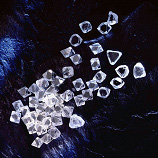
Diamonds are not really “cut” they are ground down or polished one facet at a time on a wheel covered with diamond dust spinning at 3,000 RPM’s.

Depending on the shape of the rough diamond, the cutter will decide what shape to cut, always concerned to yield the greatest value, usually meaning finishing as large or heavy as possible.
Without a doubt, the cut of a diamond is the most important factor to its beauty. Many people think they want very high clarity, as close to flawless as possible, because they think clarity will create the greatest brilliance. Not true. Higher clarity only increases the rarity and price of a diamond but not necessarily its' beauty. The Fire (flashing colors due to the prism effect), Brilliance (the amount of light reflected out the top of the stone), and the Scintillation (sparkle effect as you move the diamond), are all determined by how well the diamond is cut. This is absolutely the most important of the 4 C's. Most diamonds are intentionally cut too shallow or too deep, depending on the shape of the original rough diamonds, to increase the weight of the finished diamond and thus give it a higher "perceived" value. A poorly cut diamond is not worth what it weighs but is really only worth what it would weigh if cut properly. The better the cut, the more beautiful and valuable! Almost every diamond you see is a mediocre to poorly cut diamond. A perfect cut diamond is not very common. Most experts agree it is less than 1%. That statement may come as a surprise but it is easy to understand when you realize how much more money everyone makes by cutting and selling mediocre cut diamonds. There are so many ways to fudge on the cut making the diamond larger and heavier than it should be, always sacrificing beauty.
How fire and brilliance is created in a diamond.

Light comes in through the top of the diamond, bounces off the first side (or pavilion angle), refracts into the colors of the spectrum and then reflects off the second pavilion angle back out the top. If the diamond is cut too shallow or too deep, the refraction and reflection are reduced. Some of the light will "leak" out the bottom or side of the diamond.

Even a poorly cut diamond will have some brilliance and fire especially in jewelry stores with all the high intensity halogen lights focused on them but away from the lights will look rather dull compared to a perfect cut diamond. That is what you want… A perfect cut diamond, also called an "Ideal" cut. But please take note. In my opinion, many diamonds today are being labeled "ideal" cuts, that aren't even close.

If you didn't have my service available to you, I would recommend learning as much as possible; or even take a class or course. No doubt this is about the last thing most people want to do! With my expertise, a few clicks and a phone call is all you need.
I want to emphasize how important it is to never compromise the cut. We can be flexible in other areas to stay within any budget, BUT NOT THE CUT! You want your diamond to truly be a breathtaking miracle of nature, one that gets envious attention at every turn.
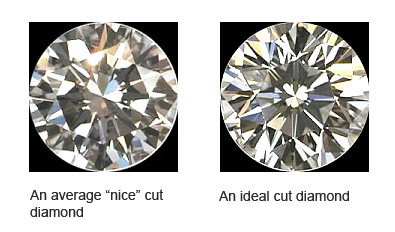
Notice how the "average" diamond has a dull, darker center compared to the "ideal cut." Also take note of the "table" (the flat top of the diamond). The lines of the "table" on the average diamond on the left form a square, while the table of the ideal cut diamond curve inward, forming concave lines. This tells me the table diameter is too large or "spread" on the diamond on the left and absolutely beautiful on the diamond on the right. This is only one of many vital factors.
The cut becomes even more complex with fancy shapes (all shapes except the Round Brilliant) because we are concerned, not only with the proportions for maximum brilliance and fire, but also with the actual shape of the stone. This gives the diamond cutter another dimension to compromise beauty for weight if he chooses to. For instance, most marquise are wider than they should be, sometimes like a football. That adds a lot of extra weight!
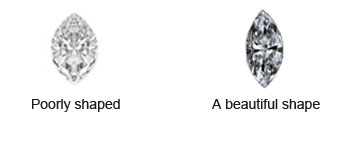
Marquise diamonds should be approx 2 to 1 ratio (length to width) but with a beautiful elegance. Pear shapes should be a delicate, gorgeous, tear drop, not a squatty pear.
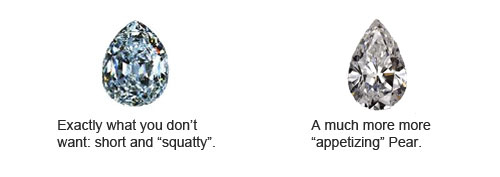
Most princess cuts are too deep and often with very thick girdles. There are just so many ways to increase the weight while sacrificing the cut. But a well cut princess can be very striking.

Remember, diamond cutting is a "for profit" business. It can be a very difficult and complex business, and I can assure you, rough diamonds are not cheap. I am sure there are many cutters who just can't make much profit without compromising the cut. This is why "perfect" cut diamonds are so rare. With my help this is the only kind of diamond you will get! A perfectly cut, incredibly fiery diamond!
Note: All "ideal" cut diamonds are not "created equal". In my opinion, today, many diamonds are being labeled "ideal" that are not even come close!
Color
Color is the next most important characteristic because you can see color with the naked eye. Below is an array of colors showing how much tint of yellow, grey or brown the diamond can have.

D is the whitest grading a diamond can have. D, E, and F is considered top "investment" grade or "colorless" and G, H, I and J are top "jewelry" grade or "near colorless." The color grades go from D to Z, but J is about the lowest I like to go. The difference between 2 diamonds with only one color difference is very slight and difficult to see but if I were to show you a D and a J next to each other you would easily see the difference. The better the cut, the whiter the diamond appears from the top because it has more light reflecting back. Looking from the top, a perfect cut J will appear whiter than a mediocre cut H. Naturally the whiter the diamond the more rare and the more valuable. I try to keep the range between D and I, but will sometimes go with a J depending on the budget.

This grading scale is not to be confused with "fancy" colored diamonds such as canary yellows, pinks, blues, greens, reds, purples, oranges, etc.
 |
 |
As a matter of fact, diamonds come in every color, more than any other gemstone. These are very rare and incredibly expensive. The most rare is an intense red diamond which can cost over a million dollars for a 1.00 carat!
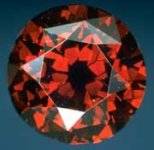
The 5.03ct De Young Red diamond can be seen at the Smithsonian Museum in Washington D.C. It is unbelievably rare and priceless!
Clarity refers to how clean or how included the diamond is. An inclusion is anything in the diamond, such as carbon, clouds, feathers, crystals, grain lines, fissures, etc. This is one area we can sacrifice to some extent in order to stay within a certain budget and still maximize the size and beauty of the diamond. Diamonds are graded under a 10X loupe or microscope. That is actually quite powerful. I would often have my clients look at their fingerprint through 10X to appreciate how powerful that really is.

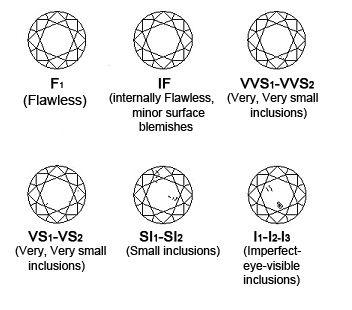
I3, I2, and I1:
These are at the lower end of the scale, I3 being at the bottom. The I stands for "imperfect" or "included". These are diamonds that have inclusions visible to the naked eye. I never recommend I3's or I2's as they are just too included and not very pretty but an I1 can actually be a stunning diamond if cut properly. I have sold many I1's where it was very difficult to see any inclusions with the naked eye. It all depends on the location and type of inclusion. The better the cut, the more "blinding" the brilliance, making it difficult to see the inclusions.
SI2 and SI1:
SI stands for Slightly Included. SI1 is a cleaner diamond than the SI2. The same holds true for the VS and VVS grades. SI clarity diamonds are usually clean to the naked eye (when viewed from the top) but have inclusions easily visible when viewing through a10 power microscope. SI1 does not mean it has 1 inclusion and the SI2 has 2. SI2 is a more included diamond, considering the total "mass" of inclusions. The SI1 could have six specks and the SI2 only 1 but that 1 inclusion would be large enough to make it a lower clarity. SI2's and SI1's are my favorite grades because the diamond appears flawless (to the naked eye) yet helps keep the diamond in a more affordable range. Please note that in 1.50ct and larger, it is very common to see inclusions to the naked eye with an SI2. All SI2's (and other grades as well) are not the same. There are high SI'2s and low SI2's. Part of my job is to find the highest SI2 (or whatever clarity grade) possible.
VS2 and VS1:
VS stands for Very Slightly Included. These are specks which are getting difficult to find even while viewing through a 10 X microscope. It would take most people a little time to find the VS2 inclusions and then they would be surprised how small they are. Most people cannot find the inclusions in a true VS1 until it is pointed out to them. Then it might look like a speck of dust inside the diamond. These are very clean diamonds, very high clarity.
VVS2 and VVS1:
VVS stands for Very, Very Slightly Included. These diamonds are near flawless. It takes practice and skill for a trained gemologist to find these inclusions through a 10 X microscope. They will appear as very, very small pin points.
IF and FL:
IF stands for Internally Flawless. These are extremely rare diamonds. Only one in many million is flawless. An Internally Flawless diamond may have an extremely small blemish on the surface that often can sometimes be polished out. FL stands for Flawless. These diamonds have absolutely no flaws under a 10 X microscope.
What Clarity do I need?
Regarding price variations, every time you go up 1 clarity grade (VS2 to a VS1 is one jump), the price will go up anywhere from a few hundred dollars to a few thousand dollars per carat depending on the size and color. The larger and whiter the diamond the greater the jump. For most people, it doesn't make sense to buy an extremely high clarity diamond, unless price just doesn't matter and they prefer a very rare diamond. That is a personal choice. When someone has a budget to stay within and wants to get the largest, most beautiful diamond possible, clarity is the best area to be flexible. SI2's and SI1's are the diamonds I prefer to sell in order to maximize the size without compromising the beauty. If I showed you an SI2 and a Flawless with everything else being equal, you could not tell me the difference with the naked eye, but the flawless can easily be 3 to 4 times the price!
Carat
Carat, abbreviated ct., is a measurement of weight. It originated in India from the carob seeds which were considered a very consistent weight. One carat equals 1/5 of a gram. One carat is divided into 100 equal parts called points. A point (pt.) is 1/100 of a carat. So a diamond that weighs ½ ct. would be .50cts. or 50 points. A diamond weighing .78cts would be ¾ of a carat plus another 3pts. Two diamonds both weighing 1.05cts may not have the same diameter because the proportions will be different. If one is deep and one is shallow they will have very different diameters. The shallower diamond will appear larger. NO, you do not want a shallow diamond for larger appearance! Never! If that ran through your mind, go back and read about Cut again. A shallow diamond will be "dull" compared to a perfect cut diamond. You would be better off with a $10 Cubic Zirconia!
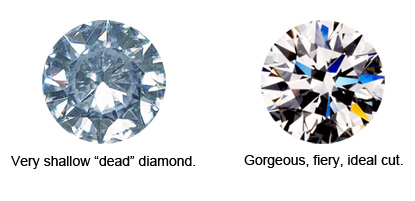
so put on your thinking cap! The larger a diamond is, the more rare it is and thus the more valuable. That is one reason diamond cutters are always trying to finish the diamond as heavy as possible and especially if it is close to a higher weight/price category. Diamonds take a jump into a higher price category at .50cts, .70cts, .90cts, 1ct, 1.50cts, 2cts, 3cts, etc. It would be very rare to find a .99ct diamond. The cutter will finish it at 1ct at least to keep it in the higher price level. Remember, diamonds are sold by weight. For example, 1.03cts X $5,000 per carat equals $5,150 total for the stone. Most cutters will sacrifice the cut to keep the diamond as heavy as possible and hopefully into a higher price category. Many diamonds that are 1ct should have been cut in the .90ct range to be perfect cuts. Let's say this 1.03ct diamond at $5,000 per carat is a decent, "OK" cut diamond (but not a perfect ideal cut). If it had been perfectly cut, it may only weigh .95cts., eight points less, but a lower price category, now $4,300 per ct. It is still the same clarity and color, but now under the 1ct price level. The value of the diamond is $4,085 (.95 ct X $4,300). So… Is it really worth $5,150 as a 1.03ct? No, only if it was cut to perfect proportions. There is more profit to be made by selling diamonds that are not perfectly cut…. at the buyers' expense. Besides the beauty, this is the other reason not to sacrifice the cut. You want value. If you buy a poorly cut diamond you lose 2 ways. You pay more than the diamond is really worth and your diamond won't be as beautiful. Can you see why "the industry" doesn't want the public to understand too much about the "Cut?"